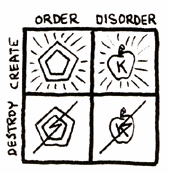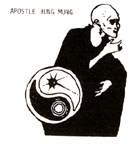Here Comes Everybody
Finnegans Wake, James Joyce's otherworldly experimental (many say unreadable) epic, has occupied my consciousness, time, & happyspace in recent weeks, as I have diligently read it aloud to myself page by page, whilst tallying hours spent (my chart currently shows seven hours & ten minutes of reading). Altho I've had th book for a while & have often enjoyed thumbing thru it whilst grinning, this represents my first cover-to-cover reading. First of many, I hope.
Th experience of reading no other book comes close to that of Finnegans Wake; it defies rational grokking. Its 628 pages of complex, multilayered puns, riddles, dreamscapes, bits of wordmusic & total lucidity entrance me. Altho oodles of articles & books have been written on it, nobody on Earth understands it completely (or probably ever will), & I think that rocks. Timothy Leary claimed that "Joyce's prose prepared [him] to enter psychedelic space."
So I plan to read it first cold, without any guidebook to help make sense of it, simply read it from cover to cover. After this, my second reading will allow one or two guidebooks (of th very many that are available - perhaps A Skeleton Key to Finnegans Wake: Unlocking James Joyce's Masterwork, by mythographer Joseph Campbell &/or A Reader's Guide to Finnegans Wake by William York Tindall). My third reading might incorporate another (perhaps Annotations to Finnegans Wake, by Roland McHugh, considered quite encyclopedic). After a while, perhaps I'll start writing my own guidebook.
At some point, I may take to th bustling streets on my weekends & recite th Wake one chapter at a time to a baffled Chicagoan audience.
It's been said that not until a person has put in 1000 hours of reading time does one start to grok th Wake. Hence my tally chart.
While not reading guides exactly, I've been reading a bit here & there about the Wake. Here's an interesting bit from Robert Anton Wilson, from his book Coincidance: "The 'nat language' of Finnegans Wake, in fact, can best be described as hologrammic prose. Just as a hologram is so structured that each part contains the whole, Finnegans Wake is structured in puns and synchronicities that 'contain' and reflect each other, creating the closest approximation of an infinite regress ever achieved in any art form."
This study may eventually lead up to a massive music project. I won't go into that now, because it may take years to get around to.
~a





1 comment:
Post a Comment